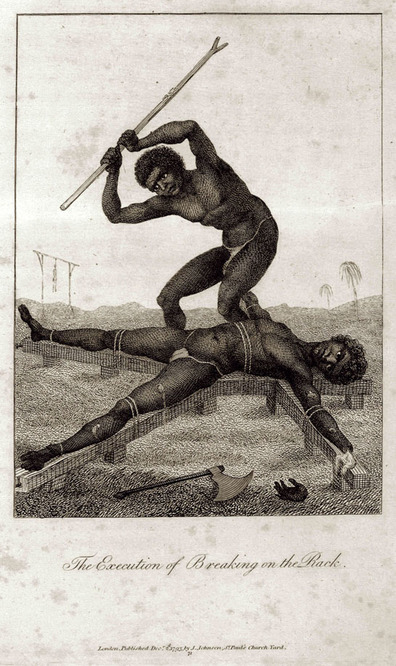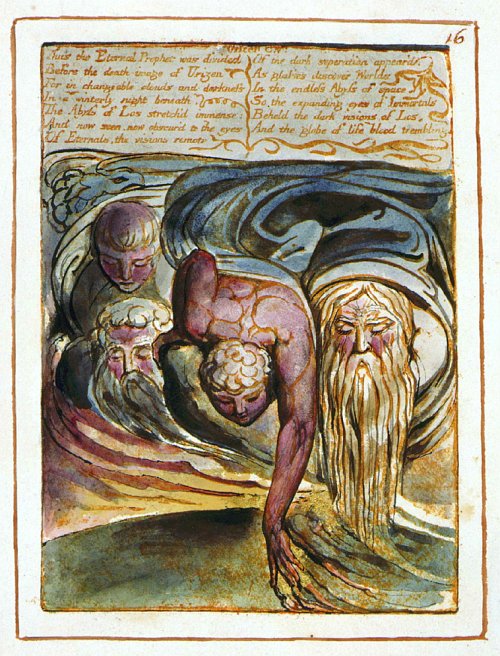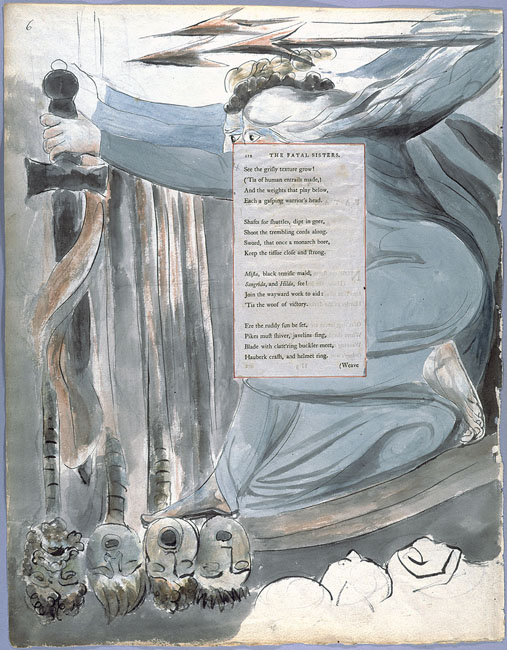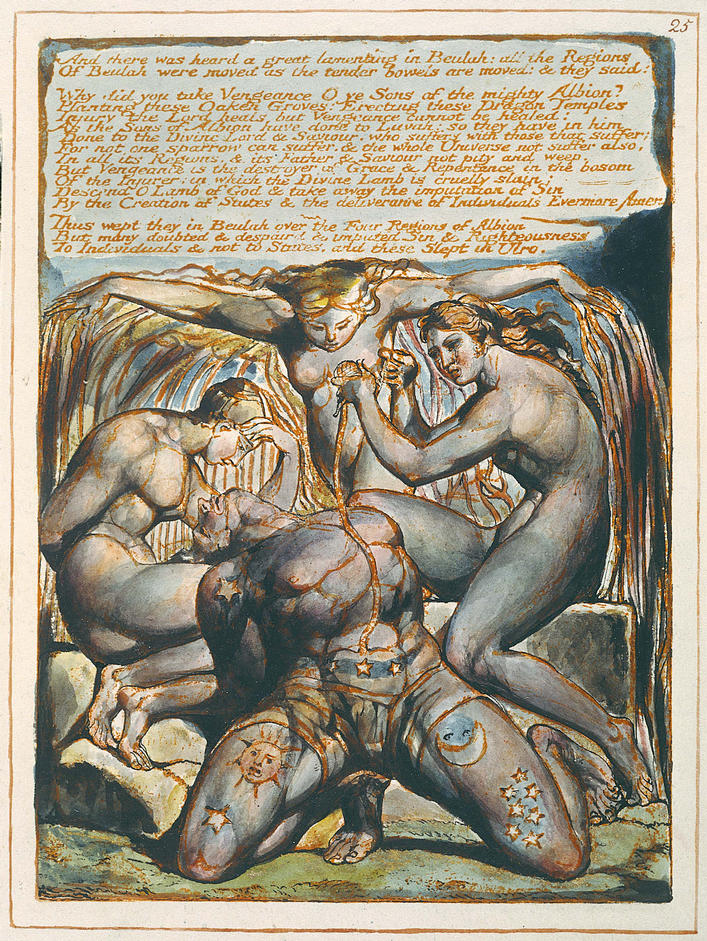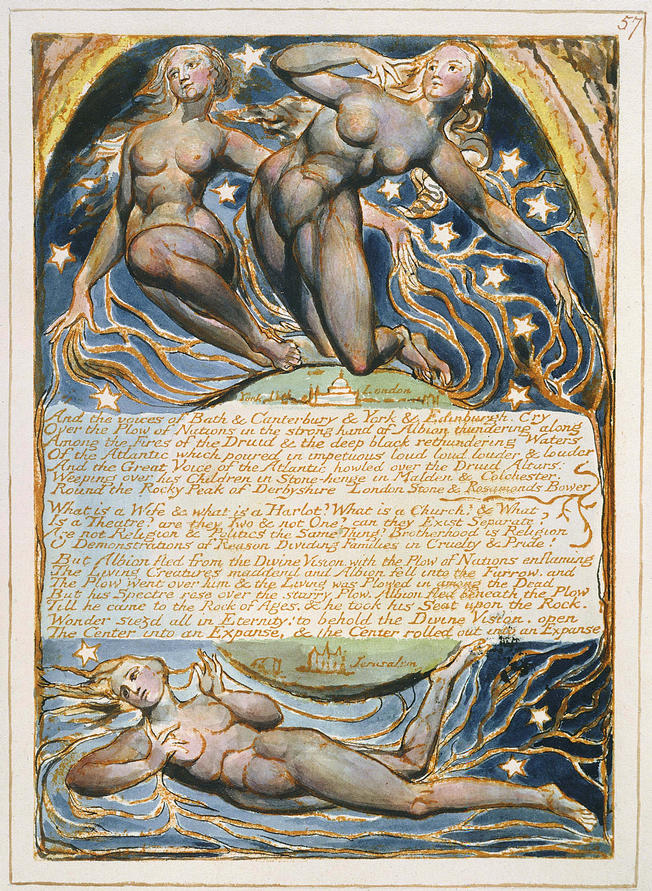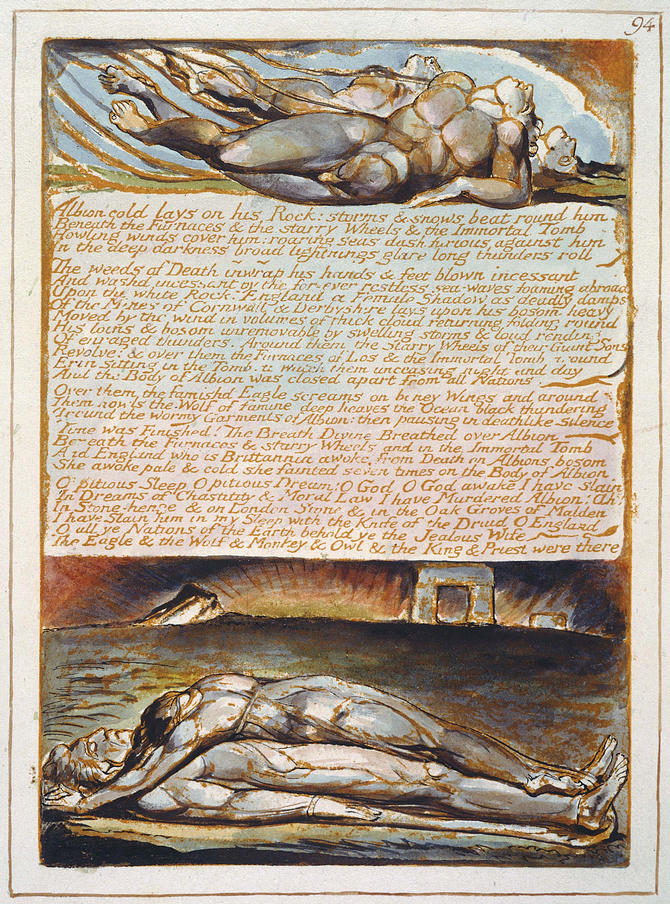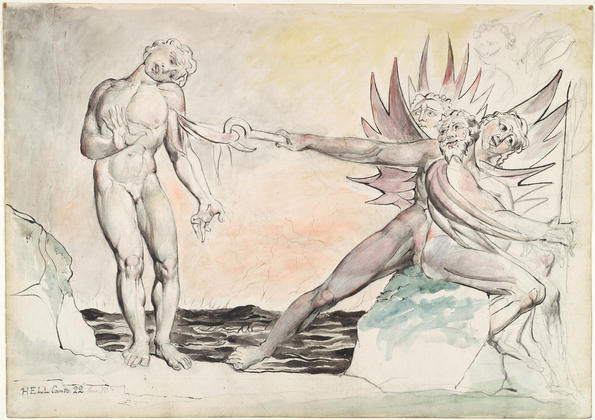As a follow-up to my earlier post, I will continue to explore the potential functions of the textual tag system in the William Blake Archive. In my previous post, I note that the tag “streams of gore” returns 18 hits in 11 different copies of works currently available on the WBA. Although not always the case, this particular collection of images spans almost the entirety of Blake’s career, from 1791 when he began engraving images for John Gabriel Stedman’s Narrative, of a Five Years’ Expedition, against the Revolted Negroes of Surinam to his completion between 1824-1827 of illustrations for a version of Dante’s Divine Comedy. These images also form a representative cross-section of the variety in Blake’s production in terms of the types of works he made, including commercial engraving, literary illustration, and illuminated books, as well as preparatory materials related to these. Although one arrives at this suite of images by focusing on a single textual tag, the visual variety within this category not only underscores my earlier point about the greater mutability of visual motifs when compared to text but also the way in which Blake continues to engage and grapple with a single conception—here, perhaps the unlikely, “streams of gore”—throughout his oeuvre.
Engravings by Blake based on drawings by John Gabriel Stedman, Narrative, of a Five Years’ Expedition, against the Revolted Negroes of Surinam, 1796 (left to right): “A Negro hung alive by the Ribs to a Gallows,” “Flagellation of a Female Samboe Slave,” and “The Execution of Breaking on the Rack”
The “streams of gore” appear earliest in Blake’s engravings after Stedman’s original drawings for his biographical account of slavery in Surinam. In each of these images, blood drips from tortured, dark-skinned bodies, all of which are restrained and nearly nude. The presence of the “gore” arguably highlights the corporeality of their bodies and, moreover, the intensity of their pain. Although the individual identities of the depicted figures are not specified, the fact that these accompany a historical account of actual events in Surinam situates such “streams of gore” within specific discourses in the period related to slavery, torture, and abolition.
Only a few years after Blake completes his engravings for Stedman, he begins designing and printing early editions of his illuminated book, The First Book of Urizen. In contrast to the historical specificity of Stedman’s text, Blake’s Urizen turns on larger thematic concerns such as the creation of the universe, morality, law, and human/divine difference. One may parallel the texts’ move from specific history to thematic abstraction with a similar decrease in visual exactitude in the “streams of gore” depicted near the bottom of the plate in copy A. Indeed, the illustration description emphasizes such ambiguity: “From the central figure’s fingers streams a substance that may be the fabric of the tent erected by the Eternals, its curtains, flesh, or Blakean streams of gore.” Copy G of Urizen arguably makes these streams of gore more legible through its particular coloring, which emphasizes the continuity between the middle figure’s left hand and the lines extending out from his fingers at right. This comparison also highlights the extent to which a text tag can vary (or in many cases disappear or change entirely) among different copies of a single illuminated book, the plates of which Blake returned to many years later.
Left: Blake, The First Book of Urizen, copy A, 1794, object 20; right: Blake, The First Book of Urizen, copy G, c. 1818, object 16
Although the illustration description for Urizen, copy A, applies “Blakean” to our focal motif “streams of gore,” Blake does not retreat into original production after the earlier Stedman works. Illustrations for others’ poetry continue to inform the way he depicts various streams of gore. Commissioned in 1797 by Blake’s friend, the sculptor John Flaxman, as a gift for his wife Ann, the 116 water-color illustrations to Thomas Gray’s poems are among Blake’s major achievements as an illustrator. His illustrations respond to Gray’s poems in a variety of ways, but always with respect for the specifics in the text. Many motifs are visualizations—and hence literalizations—of Gray’s metaphoric images, and such is the case with “The Fatal Sisters: Page 6,” object 72, which is marked with the “streams of gore” text tag. One can immediately recognize parts of human bodies on the left side of the design but the meaning of the streams-of-gore motif here is incomplete without recourse to the accompanying text.
“See the grisly texture grow!
(‘Tis of human entrails made,)
And the weights that play below,
Each a gasping warrior’s head.
Shafts for shuttles, dipt in gore,
Shoot the trembling cords along.
Sword, that once a monarch bore,
Keep the tissue close and strong.”
(1-8).
Abstracted, the gory bodies here literalize an image of corporeal weaving. Yet the anguished expressions of the four heads near the bottom margin arguably anchor this “streams of gore” image within Blake’s previous depictions of bloody, pained bodies.
Blake, Illustrations to Gray’s “Poems”, object 72, c. 1797-8, “The Fatal Sisters: Page 6”
Streams of gore appear most frequently (four times in different plates) in Blake’s final and longest epic Jerusalem The Emanation of The Giant Albion, which included 100 plates designed and etched between 1804-1820. Although the bodies in these plates typically appear as recognizable wholes (like those in Stedman), they also draw on Blake’s earlier use of the motif in Urizen and his illustration to Gray’s “Poems” through their expansion of the body with networks of entrails and bodily vessels. These streams of gore, thus, not only appear to cause pain when manipulated by others (as in the case of Jerusalem object 25) but also connect figures to each other and the environment around them. These images, as well as the accompanying text in some cases, prompt considerations of the autonomy of bodies (particular the separation of inside and outside) and the relationship of bodies in the world to the physical, divine, or mythological worlds they inhabit.
Blake, Jerusalem The Emanation of The Giant Albion, 1821, (left to right) objects 25, 57, 74, 94
The latest work in which the “streams of gore” tag appears is Blake’s illustrations to Dante’s “Divine Comedy,” object 43, from 1824-27. The gory stream, or rather loop in this instance, constitutes the central focal point of the image and connection linking the figure at left, Ciampolo the Barrator, who looks down at the wound, with the group of devils at right, one of whom wields the hooked weapon. Directly below the hooked flesh, Ciampolo’s contorted right hand highlights the figure’s pain, in a way not dissimilar from the contorted bodies in Blake’s illustrations to Stedman.
Blake, Illustrations to Dante’s “Divine Comedy”, object 43, 1824-1827, “Ciampolo the Barrator Tormented by the Devils”
More than anything, however, this tour through Blake’s “streams of gore” illustrates a potential way to use the textual tagging system to trace a single motif and all its variations throughout his productions across time and media. Without the assistance of such a digital tool, one may never know (gasp!) the extent to which stream of gore—or a huge number of other motifs—recur in many manifestations in Blake’s works.



